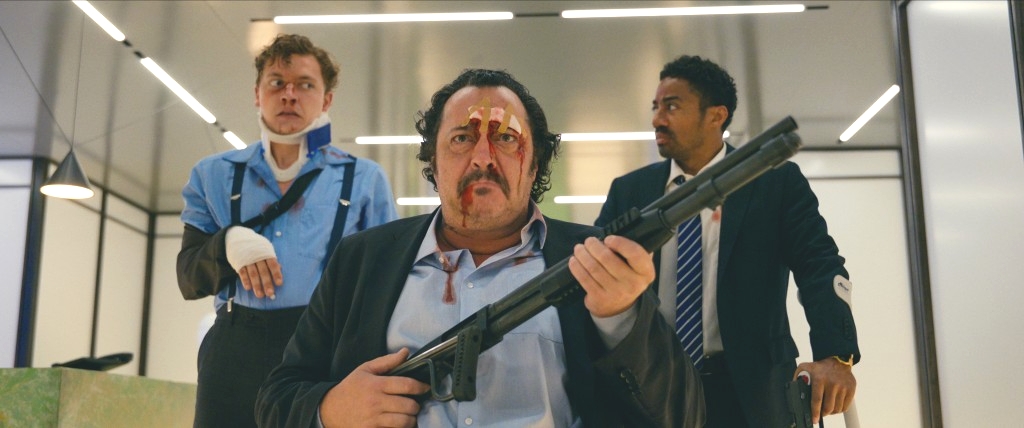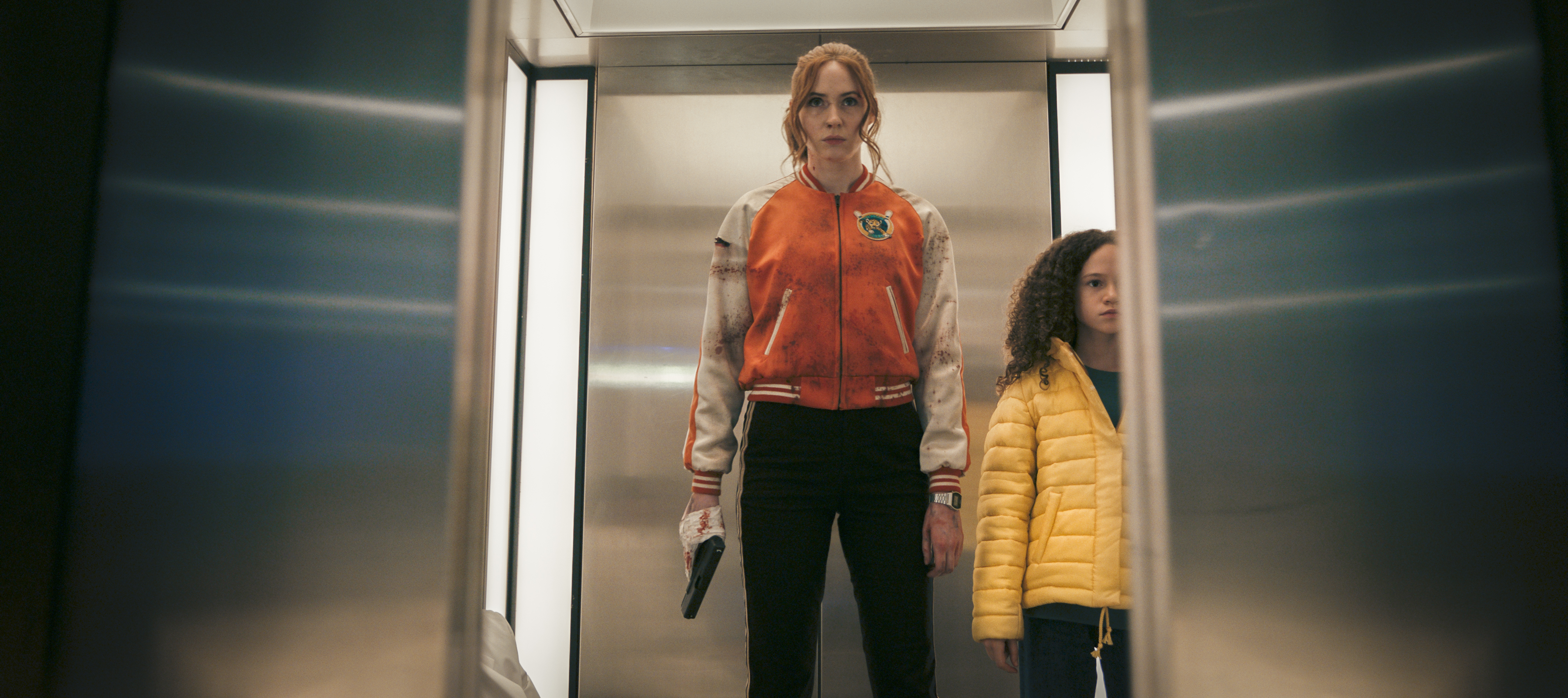There are plenty of homages to be found in Netflix’s latest aesthetic action romp, Gunpowder Milkshake.
Keen-eyed action aficionados might find odes to the freewheeling underdog stylings of Jackie Chan in a certain bowling alley brawl, a French Connection nod in a hilarious car chase sequence, a gratifying Kill Bill throwback in a costume choice, or a John Wick-modeled showdown in a Baroque library where books double as gun cases and librarians know how to wield hammers with surprising efficiency.
But even amidst the slick set pieces and neon-drenched shoot-em-ups, one showdown in director Navot Papushado’s stylish punch-fest stands out. Mid-film, Karen Gillan’s Sam – a hitwoman for hire whose latest job has saddled her with an unwelcome, underage sidekick – must survive a Spaghetti Western-style stand-off with three goons in a dental clinic. Her attackers are injured – they shuffle awkwardly on crutches, in neck braces, and using wheelchairs – and they’re also high as kites on laughing gas. Sam is equally handicapped, having been injected with a paralytic agent that renders her arms useless. So, naturally, she improvises, and in the process, Papushado delivers the film’s most memorable, most surreal action sequence.
It’s inspiration? Roger Rabbit.
“We wanted the fight sequences to feel different,” Papushado tells UPROXX. “The clinic especially was very heavily inspired by cartoons; Buster Keaton and Who Framed Roger Rabbit.”
It’s the humor that spoke to Papushado’s directorial style.
“In Roger Rabbit, they’re laughing but they’re dying. We just went, ‘Okay, can we take that and just dial it up to 11?’ Like making something that’s really bananas. For me, that’s my childhood, watching cartoons on Saturday morning.”
That sense of whimsy played a role in everything, from the design of the clinic – shot on location in Berlin – to the music that scores the scene. It’s claustrophobic, a narrow hallway filled with flying bullets and clunky fist fighting, and unforgivingly lit – bright whites and neon greens make blood splatter and detached body parts easier to spot. The music, a maniacal Mariachi mix Papushado ended up opting for in post, only serves to heighten the absurdity of watching these professional assassins stumble about, lodging scalpels in jugulars and biting each other’s ears off.
Each character had their own theme music and Papushado often played music while shooting to “set the mood.”

“The goons, the three boneheads, were always a little bit more of the Western-style, the way Sergio Leone would cast everyone,” he explains. “They’re not sleek and handsome and they’re not working out at the gym now. These are guys, where if you look very carefully, there’s a little mustard on their shirt and they’re not in the best shape. I would play them the last track from The Good, The Bad and the Ugly, and it sort of became their theme.”
For Gillan, getting hype to shoot the clinic fight required a more unique playlist.
“I played two songs, one was from a composer called Stelvio Cipriani, which is very Italian chic,” Papushado said. “The other thing we did, because Karen is such a big fan of the Muppets, we’d play that theme song. We knew it had to be silly, we had to commit to the tone, so between takes we’d say, ‘Alright guys, it’s time for the Muppet song again. Everyone get into their Muppet zone.’”
For stunt coordinator Laurent Demianoff, that humor had to extend to the page, where he crafted the fights, pulling kung-fu comedy influences and working them into Sam’s larger character arc.
“You’re not thinking the same way as when you’re choreographing a regular fight,” Demianoff told UPROXX. “It’s very different because everybody is handicapped. It’s very cartoonish but very violent. So that was really fun to write at first. And then very challenging because we were thinking, ‘How can we do that on-screen?’”
Most of the fighting was intuitive. Demianoff would task his stunt team with rehearing moves, imagining how Gillan would fling her arms one way to aim a gun, another to incapacitate an attacker on crutches. They rehearsed all of the fight scenes for the film in just two weeks, with Gillan putting in weekend hours so that her muscles could memorize the choreography and she could be free to play up the comedy of her character’s dilemma.
“It was more about acting than just being great at action,” Papushado explained. “They don’t need to deliver something very elegant, no, it’s the other way around. They need to act bad, they needed to play like they’re wounded, they’re crippled and they’re fighting for their lives. This time around, it’s not being cool and slick and ‘come and get it,’ like the bowling alley. No, no, this time she’s a wounded animal. She’s fighting for her life. She’s giving everything she got and so are the three other guys. So it was more about the acting and delivering that kind of wild animalistic vibe, which Karen, I mean, she’s incredible. She can change gears in a heartbeat. One moment she’s funny, one moment she’s dangerous. One moment she’s with her back to the wall. One moment she’s chewing someone’s ear …”
That constant change in tone during the film’s many fight scenes is what drew Gillan to the movie.

“I’ve read a lot of action sequences in scripts before and they’re a lot easier to watch than they are to read and it’s usually because there’s a lot of explanation,” Gillan said. “On the page, it’s quite hard to understand how it’s going to make sense visually, but this was so easy to follow and it was also highly original and full of sequences I hadn’t seen before.”
For Papushado, as fun and entertaining as the action is, it also needed to serve the story. He’d seen enough of the Jason Bourne class of action movies, the ones with spectacular, heavily-edited fight scenes and city chases that are exhilarating to watch in the moment, and then forgettable once you step outside the theater. The superhero fare that glosses over the more violent matchups, using CGI and conveniently timed cutaways to deliver something polished but often hollow.
“Jason Bourne was amazing, I remember seeing that movie and being like, ‘Wow, I haven’t seen that before,’” Papushado said. “But since then, it became kind of the standard, because sometimes it’s just easy. You don’t have to stay on the shot for more than two seconds. I’m a little bit fed up with it. You hear the punch, but you don’t see it.”
It’s what sets the entire film’s approach to the gun-fu genre that’s come to dominate so many of the “women kicking ass” offerings of the past few years apart. It’s not just violence for violence’s sake. In every action sequence, Papushado questions what the bruises and battle scars will mean for his heroine moving forward and what the audience will walk away appreciating the most from her fight for survival.
“I was fortunate enough to be supported by an amazing stunt coordinator and trainers,” Papushado continues. “Because there’s nowhere to hide, everything needs to look good and they need to actually land those punches. For me, it just makes more memorable set pieces, more memorable ideas, but it also captures the emotion and the story in it.”







